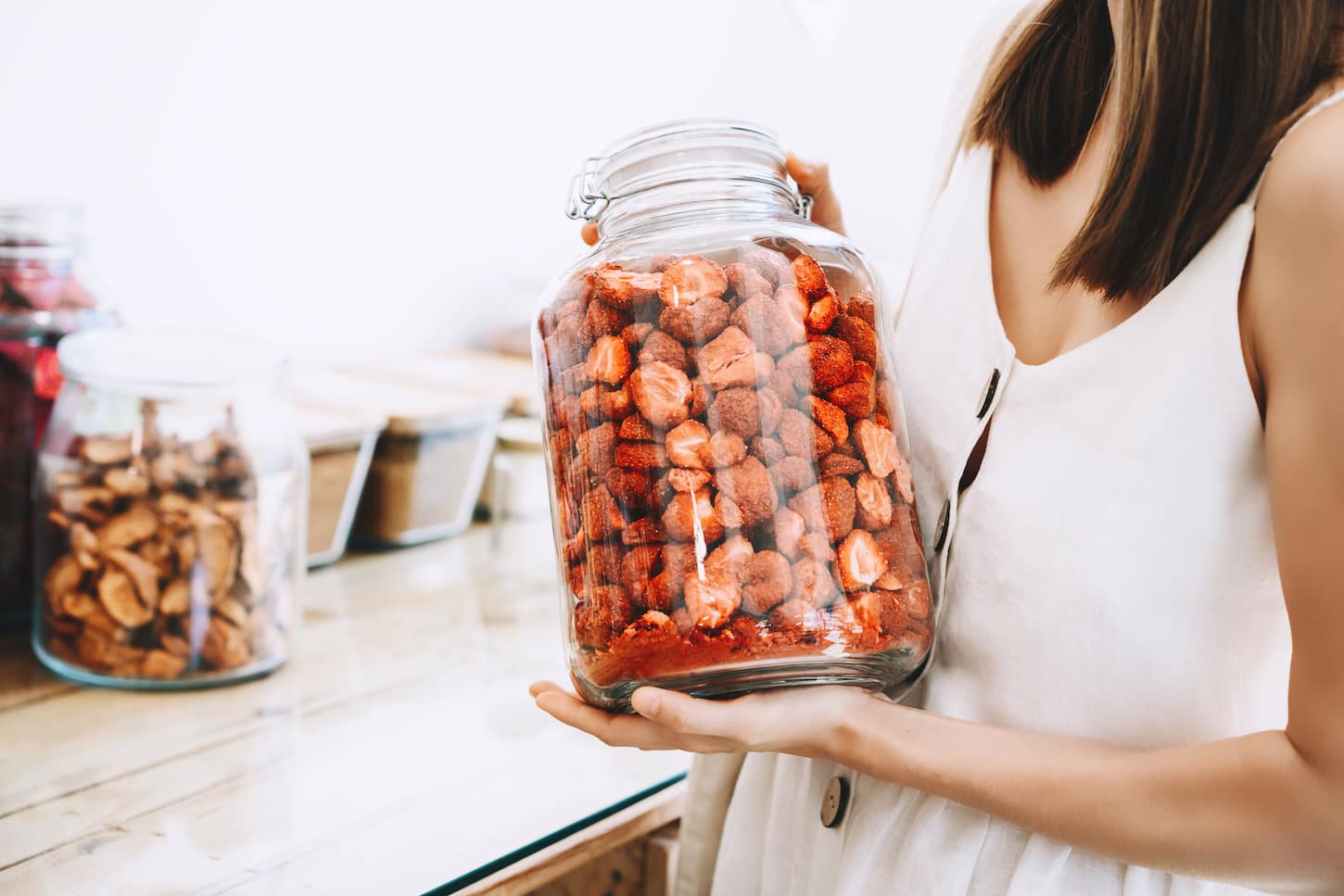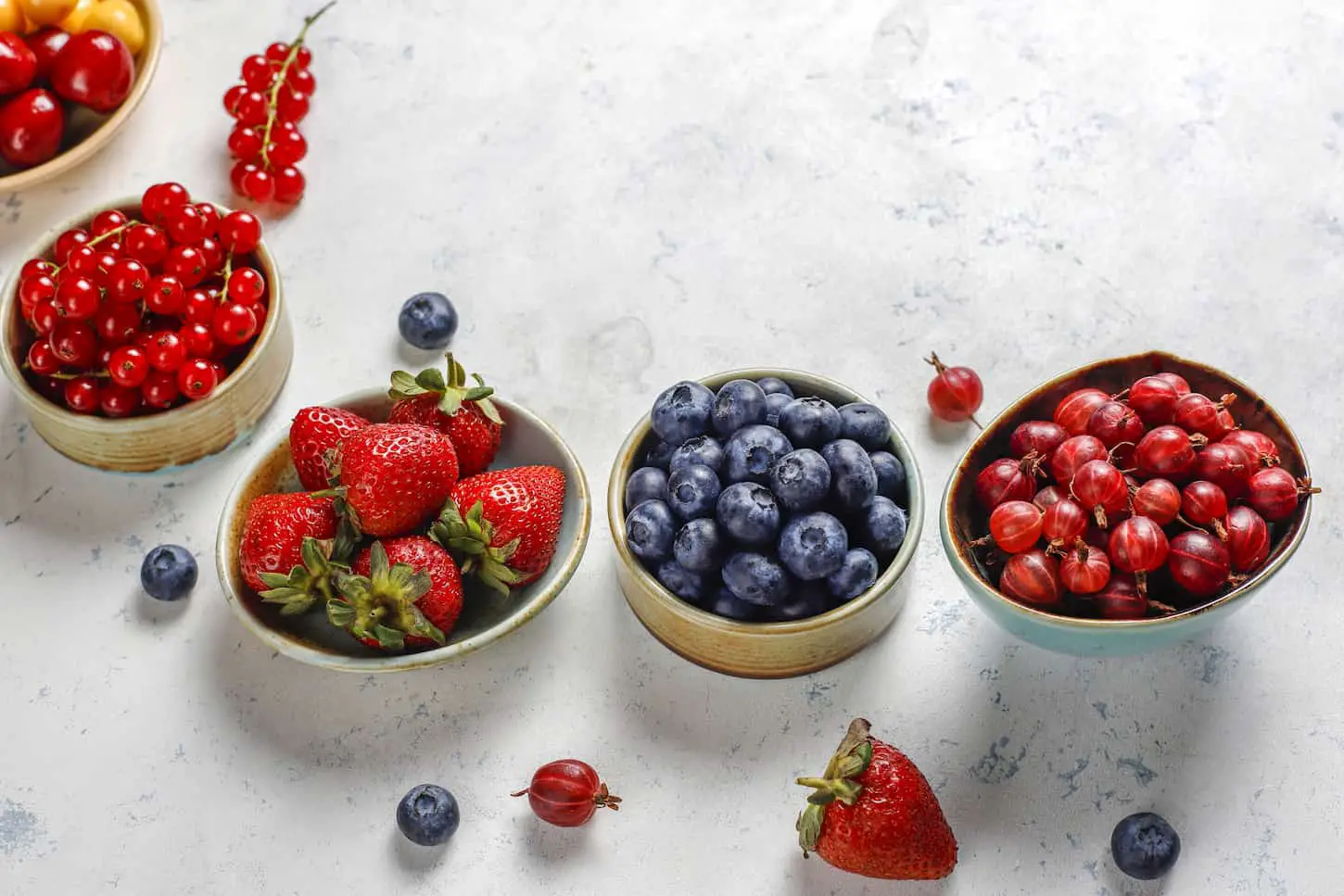Freeze-drying is a new method of long-term storage, as it was only introduced in 2013, but it has the potential to be the longest-lasting storage method. Many people are interested in freeze-drying berries, among other fruits, and here’s how!
To freeze-dry berries, you have to do the following:
- Wash the berries in clean water and dry them.
- Cut the hard-shelled berries in half.
- Pre-freeze them if possible (makes the process much easier).
- Start the freeze-drying cycle in the freeze-dryer.
- Store them in Mylar bags (or mason jars) with oxygen absorbers
- Put the containers of freeze-dried berries in a cool, dry, and dark place.
Freeze-drying is not only a long-lasting option but also requires little participation from you. Read on to learn all about freeze-drying berries and how well it works.

Can Berries Be Freeze-dried?
Berries can be freeze-dried, just like most fruits. This is an easy way to preserve food for a long time. It is a favorable option for rehydration – freeze-dried products rehydrate better than dehydrated products.
This way, the berries won’t lose much taste or texture when rehydrated.
Aside from berries, we can freeze-dry apples, cherries, bananas, kiwis, melons, peaches, nectarines, plums, and apricots.
Which Berries Don’t Freeze-Dry as Well?
Berries with tough outer shells are more difficult to freeze-dry. The same rule applies to regular dehydration, too – it is difficult to get rid of all the moisture with such a shell. This includes blueberries, cranberries, and lingonberries.
Grapes, which are technically also berries, don’t freeze dry well for this very same reason.
Raspberries, for example, don’t have a hard outer shell, which makes them easier to freeze-dry.
We must cut the berries in half to deal with this hard-shell problem. While whole berries can freeze dry, the process is easier and quicker if we cut them in half.
Citrus fruits are notoriously difficult to freeze-dry for this exact reason. The moisture won’t be extracted properly unless we take off the peel.

How to Freeze-dry Berries: a Step-by-step Guide
Freeze-drying berries is no different from freeze-drying any other fruit.
Preparation
To freeze-dry berries, we’ll need the following:
- A freeze-dryer
- Berries
- Ziploc and Mylar bags
- Oxygen absorbers
Step 1 – Wash the berries
This should go without saying but always wash the fruit before freeze-drying it (and before eating it). We also have to dry it before putting it in the freeze-dryer.
Any moisture, be it natural or water from washing, will affect the process and make it more difficult.
Step 2 – Cut the berries in half (if needed)
We should cut them in two if we’re freeze-drying hard-shelled berries (like blueberries). This will open the berries up enough to help the freeze-drying process extract the moisture.
If the berries are particularly large, we’ll have to cut them regardless of the hardness of the shell. The pieces shouldn’t be more than 1 ½ inches in length and width.
Step 3 – Pre-freeze the berries
Do yourself a favor and pre-freeze the berries in the freezer – this will make the freeze-drying process easier and noticeably quicker. Only move on to the next step once the berries are frozen – don’t let them thaw in between.
Of course, if we desire, we can freeze-dry them without freezing them beforehand, but the process takes more time.
Another con of not freezing before freeze-drying is that we’re leaving the berries open to bacteria – bacteria don’t develop in the freezer because it’s too cold for them.
Step 4 – Run the freeze-dryer
When loading the berries inside, don’t overcrowd them on the tray – they won’t freeze-dry properly. Only lay down a single layer of berries on the tray and use a liner to prevent sticking.
Close the door on the dryer and the pre-frozen cycle (or the cycle for fresh fruit if you didn’t freeze it beforehand).
That’s it! All we have to do now is wait for the cycle to end.
Step 5 – Store the freeze-dried berries properly
Once the berries are finished, put them in Ziploc bags in a cool, dry, and dark place for a day. This is to test the berries for moisture – if we did everything right, there should be condensation in the bag.
To store berries for a long time, use Mylar bags with oxygen absorbers.
Another good option is storing the berries in mason jars. Our guide here will tell you exactly how to do it properly!
Step 6 – Put the containers in a cool, dark, dry place
Keep the berries in a dry pantry; in an ideal scenario, they can stay edible for up to twenty-five years.
How Long Do Berries Last When Freeze-dried?
In truth, there’s no definitive answer to this question. In theory, freeze-dried berries will last for 25 years or more. Many freeze-dried foods can last longer than that, although they may lose more nutrition after the first 25 years.
In theory – freeze-dried products should last up to 25 years if properly stored.
Freeze-dryers can extract 98% of the moisture from food, and the vacuuming part of the process removes all the air. The results are incredible – there’s no moisture, so there’s no room for bacteria, yeast, and mold to develop.
And since there’s no oxygen, the crucial element for the degradation of organic matter, the natural spoilage that would normally occur is also stopped.
However, just because berries are freeze-dried doesn’t guarantee they’ll last 25 years – especially if we don’t store them properly. We can shorten the shelf-life of freeze-dried food if there’s too much light and moisture in the storage space or if the temperature is too high. If this is the case, they won’t last as long.
Light causes discoloration, so storing fruit in a dark room is always recommended. Moisture will cause the development of bacteria – this usually happens if there’s an opening in the bag or the jar.
The storage temperature should always be below 75°F, as warm temperatures will reduce the shelf-life significantly.
Oxygen will also cause a problem for reasons explained above – it usually comes in contact with freeze-dried products if we break open the storage bag.
There is more information about freeze-drying fruit. Read our complete guide (with pictures) right here.

What’s the Best Way to Store Freeze-dried Berries?
The best way to store freeze-dried food long-term is in a Mylar bag with oxygen absorbers. Freeze-dried foods can also be stored in Mason jars, plastic containers, and bags. However, as these containers are porous (allowing in trace amounts of light and/or air), they aren’t as good as Mylar.
Glass jars (or Mason jars) are another option. We can also use oxygen absorbers in mason jars, and they will keep the food edible for years.
Lastly, metal cans are another option – perhaps as effective as Mylar bags – but storing food in metal cans requires more prep work.
How to Use Freeze-dried Berries
Freeze-dried berries can be used like fresh berries in cooking or as snacks. However, they may require added water for some recipes, like jams. Freeze-dry berries are also great for snacks, emergency preparedness, or preserving food for decades.
If we buy or harvest too many berries and they will go bad if we don’t eat them soon, freeze-drying is the best way of keeping them edible for a long time.
Freeze-dried berries can also be eaten right out of the bag (if you’re eating lots of freeze-dried foods, make sure to drink plenty of water or you’ll get all sorts of stopped up!), or we can rehydrate and use them for cooking.
Simply soaking the berries in water will rehydrate them.
Do you love homemade jam? Check out this recipe. It’s our favorite one!
Advantages and disadvantages of freeze-drying
Freeze-drying can preserve foods for longer than any other storage method – theoretically, up to 25 years. It can also preserve foods other methods won’t work on, such as dairy products and eggs.
It also requires very little participation – we have to load the freeze-dryer properly and press a few buttons.
The food won’t lose any nutritious value, and the taste will remain mostly the same. Compared to all other long-term storage methods (dehydration, canning, and freezing), freeze-dried foods are (in my opinion) the best option. Not only do they retain most of their original freshness and nutrition, but they are still usable like the original food.
The two biggest disadvantages are the size of the machine itself and the price. Freeze dryers are large and heavy – they take up a lot of space and usually take at least two people to move around.
They can be expensive, as the cheap ones typically cost about $2000. But they’re an investment into the future and should be seen as such. If you want to know more about why freeze-drying is expensive, we’ve got a detailed explanation with cost analysis here.
Aside from that, there are a few minor cons, but they’re more nuisance than anything else. Freeze-dryer pumps heat up, so they must be kept in a well-ventilated area.
They can also get noisy, almost as loud as a vacuum cleaner, but that only happens during the vacuuming part of the freeze-drying process. So if you’ve got a well-ventilated room with a door? You’re set. That’s what we do!
Lastly, it can take up to two days to freeze-dry some foods (in extreme cases).
This makes them a good fit for people who have the money to invest and a room where the freeze-dryer won’t disturb anyone (a basement, for example).
Read about the advantages and disadvantages of freeze-drying in our article: The Advantages and Disadvantages of Home Freeze-Drying.

To Sum Up – Freeze-drying Berries
Freeze-drying is the most efficient way of storing berries for the long term. After freeze-drying, they can stay stored for up to 25 years if kept in a dark, cool, and dry place.
If we don’t want to throw food away, we should consider investing in a freeze-dryer. It is, however, an investment – these machines can reach significant costs as they’re not easy to make, but they’ll surely pay off in the future. Our freeze dryer has already more than paid for itself.
If you want to know more about freeze-drying, here are some articles packed with information and how-tos and information.
- Complete Guide to Freeze-Drying Yogurt and Kefir
- Can You Freeze-Dry Mixes? Pancakes, Waffles, Cakes Etc.
- How Much It Costs To Run A Freeze Dryer: The Complete Guide
- 17 Reasons You Need a Freeze-Dryer
Resources
Learning from your own experience is essential, but learning from others is also intelligent. These are the sources used in this article and our research to be more informed as homesteaders.
- “Buying a Home Freeze-Dryer: What to Know Before You Go.” USU, 27 Oct. 2022, extension.usu.edu/preserve-the-harvest/research/buying-a-home-freeze-dryer-what-to-know-before-you-go.
- Hirneisen, Andy, MA, and Nicole Mph McGeehan. Let’s Preserve: Freeze Drying. extension.psu.edu/lets-preserve-freeze-drying.
- “What a Great Idea, How Come Nobody Thought of This Before?” Rural Development, 25 Aug. 2022, www.rd.usda.gov/newsroom/success-stories/what-great-idea-how-come-nobody-thought.
